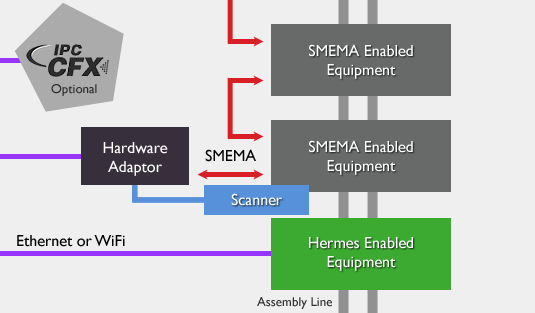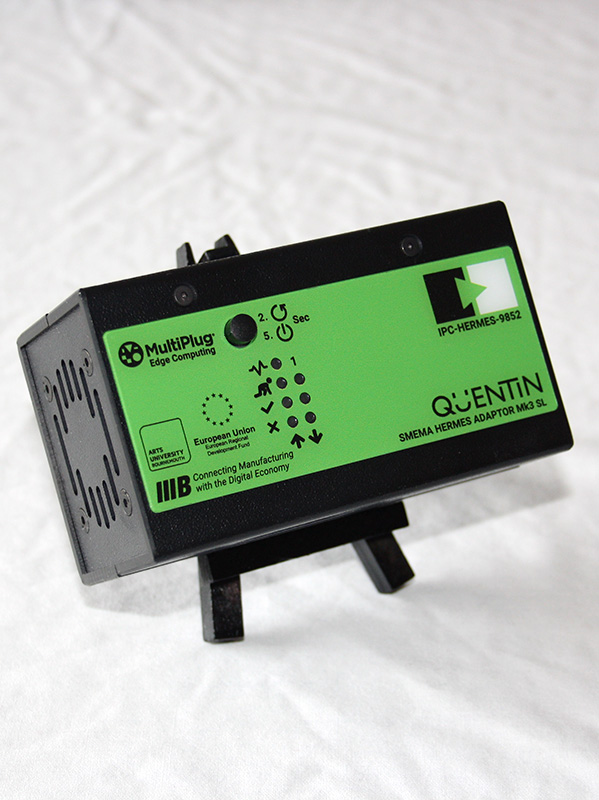

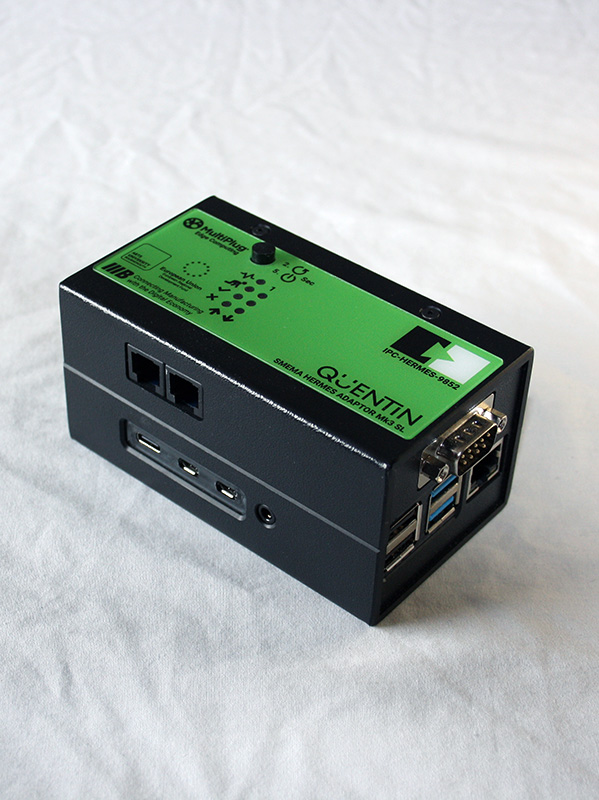
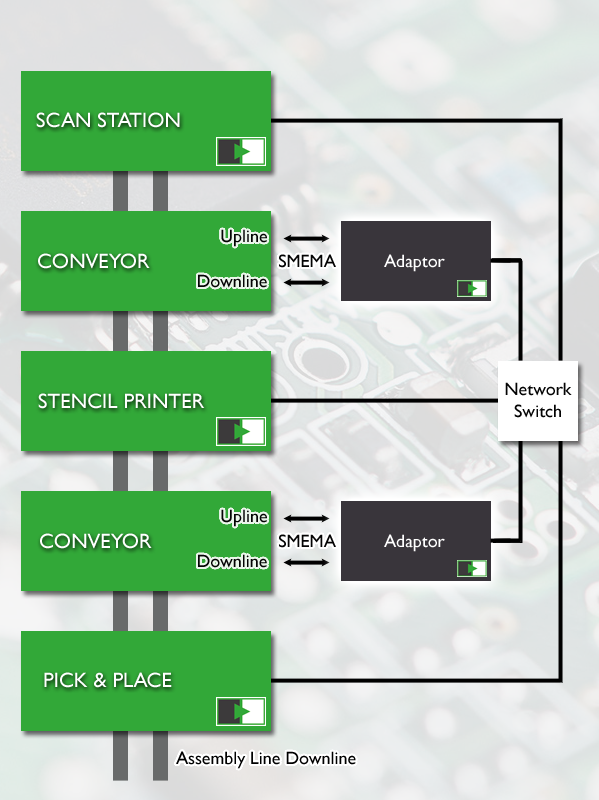
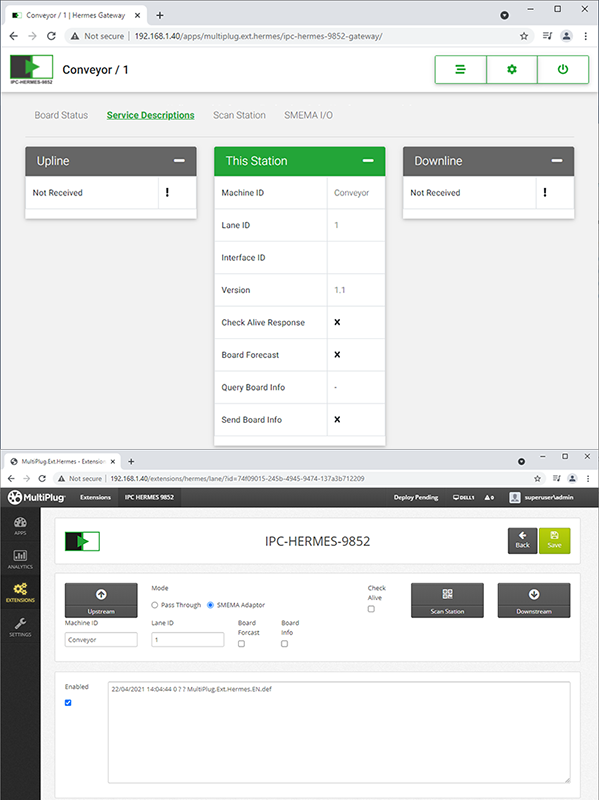
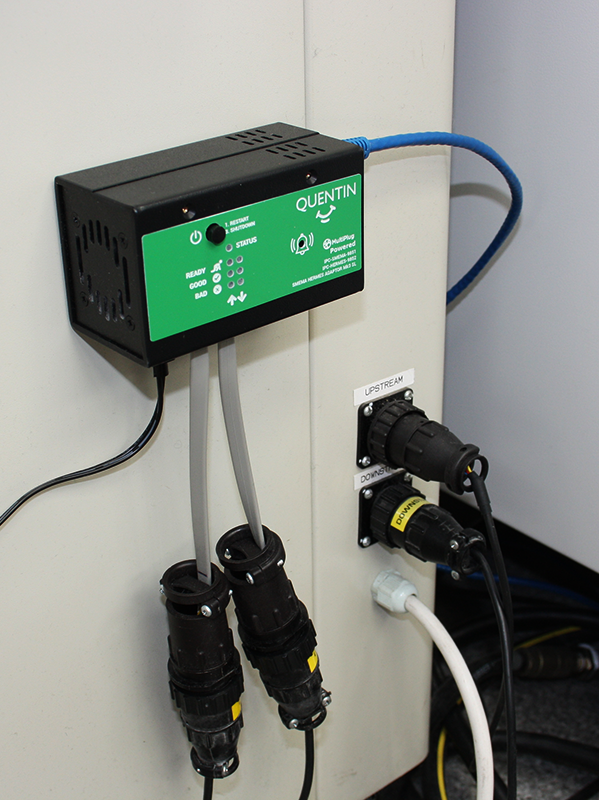
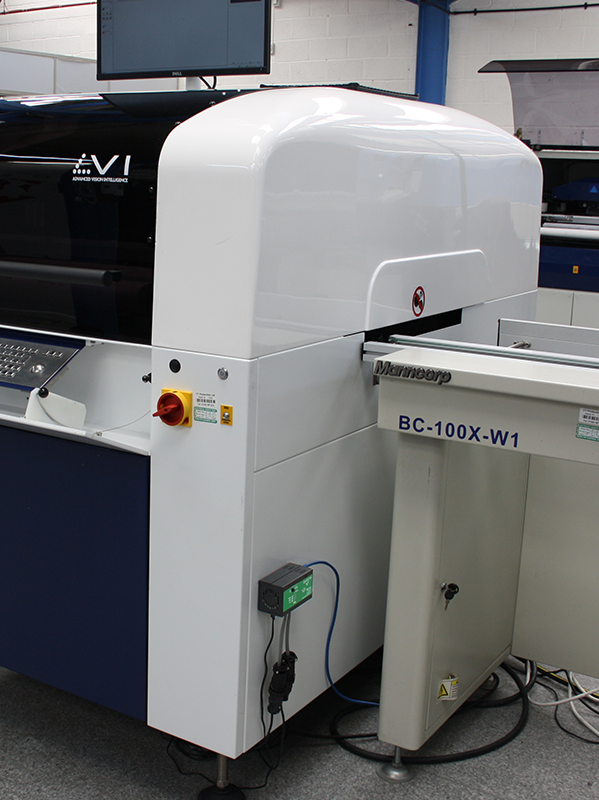
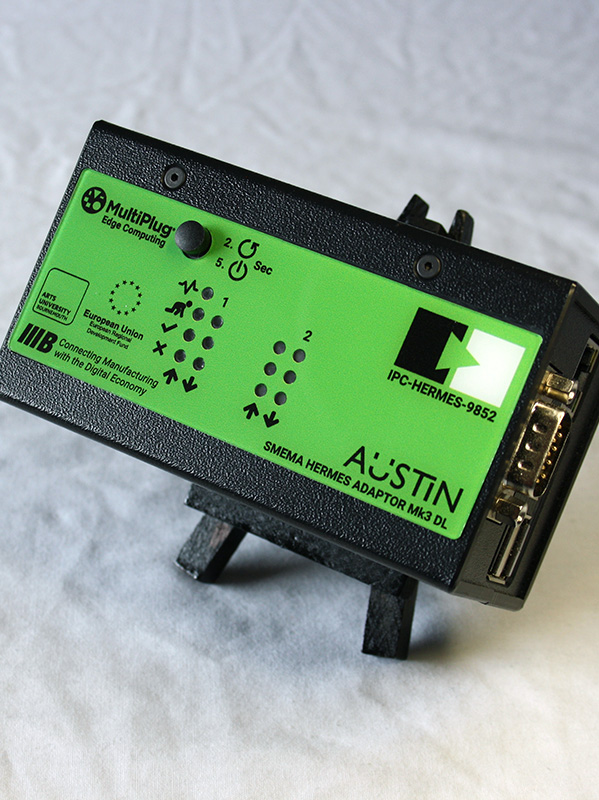
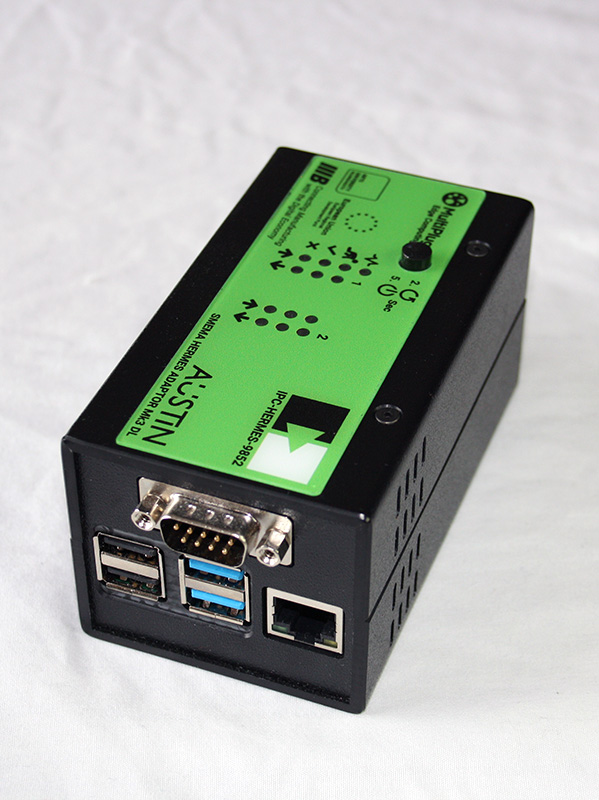
SMEMA Hermes Adaptor
QUENTIN : Single Lane (SL) - AUSTIN : Dual Lane (DL)
With the release of the IPC-HERMES-9852 Standard and its intent to replace the existing SMEMA standard, SMT manufacturers require an upgrade path for their existing equipment.
Where available, an software upgrade is the obvious upgrade path for manufacturing equipment, however this may not be available for 'dumb' equipment such as conveyors.
Quentin, our SMEMA Hermes Adaptor mimics the SMEMA Upline and Downline states, by retrieving the Hermes board data from the equipment previous in the line, and retrieves the Hermes Ready, Not Ready, state from the equipment next in-line, this is then converted into SMEMA signals for the legacy equipment to interpret.
The Adaptor is a hardware device that has both Upline and Downline SMEMA JR12 Connections, an Ethernet port for Hermes connections, and runs on a powerful single board computer. One Adaptor is required for each piece of equipment that lacks Hermes compatibility.
An RS232 serial port is available for automatic conveyor width adjustments or other legacy equipment communication.
Configuration is conducted by a MultiPlug Extension which also handles all the Hermes software connections.
QUENTIN Mk3 SL | AUSTIN Mk3 DL
An upgrade path to use the Hermes Standard on legacy SMEMA SMT manufacturing equipment
- Compact Design
- Low Cost
- Speedy Setup
- Headless Device
- Software Extendable via the MultiPlug Edge Computing Platform
A product website can be viewed at: www.the-hermes-standard-smema-adaptor.info
Newsletters
- July 2023 - Software Update
- December 2022 - Software Update
- September 2022 - Software Update
- August 2022 - Software Update
- November 2021
- April 2021
- February 2020
Typical Applications
- SMEMA Hermes Adaptor
- SMEMA Hermes Gateway
- SMEMA Hermes Bridge
- SMT Equipment Integration
- SMT Scan Station
- SMEMA Interlocking
- Inspection Station
- Data Logging
- Data Exchange
- MES Interlocking
- General I/O
Videos
- MPN
- Quentin: B5145A45. Austin: B5145A55
- HS Code
- 8517 62
- SMT Lane Configuration
- Quentin: Single Lane. Austin: Dual Lane
- Size
- Length 109 x Width 62 x Height 55 - Weight 227 grams
- Computer
- 2GB RAM, 32GB Storage. Linux. Single Board Computer
- Network
- Ethernet or WiFi. WiFi Access Point for remote setup and monitoring
- Input voltage
- 5 Volt Supply via USB-C - optional industrial 24v stepdown
- Connectors
- 2 x RJ12 SMEMA Sockets. RJ12 Plug to SMEMA Plug or Socket Dongles (optional accessory)
- Indicators
- SMEMA and Hermes status and audible alarm indicator
- Buttons
- Shutdown / Restart
- Data
- RS232 Serial Port for Conveyor integration
- SMEMA Switching Max
- 30V DC
- Mount
- Din Rail, Magnetic or Wall
- Real Time Clock
- Yes. For accurate data logging
- Cooling
- Active
- MultiPlug Extension
- MultiPlug.Ext.Hermes
Cables
Mounts
- SMEMA Adaptor Family Din Rail Mount
- SMEMA Adaptor Family Magnetic Mount
- SMEMA Adaptor Family Wall Mount
Power Supplies
Questions from customers:
Do the adaptors still send out the SMEMA signal to the next machine down the line or does the next machine need to have an adaptor as well?
All equipment that can't be upgraded to the new Hermes standard needs its own adaptor. One adaptor per equipment.
Do you have many customers that are using the adaptors?
As the Hermes standard is still immature we have customers running pilot production lines using the Adaptor.
What has been the typical reasons / benefits for using the adaptors?
The adaptors are typically being used for conveyors and out-of-support manufacturing equipment. The adaptors are extending the life of this old equipment and bridging the gap while new equipment is sourced.
Would it be possible for us to buy these units from you rebadged with our name?
Yes. We are able to produce labels to your specification.
It is possible to have some datasheet/brochure?
A datasheet is available here.
Is there a product website?
Yes: www.the-hermes-standard-smema-adaptor.info
Do the adaptors support the CFX (Connected Factory Exchange) standard as well?
The short answer is you can use the CFX MultiPlug Extension to push PCB data into the CFX but you still have to use Hermes MultiPlug Extension to conduct the data connection and handshakes using Sockets and XML.
The longer answer is the Hermes standard is tightly coupled to TCP Sockets and XML, where CFX uses AMQP and Json. In the Industry 4.0 era we shouldn't be coupling ourselves to transport technologies, rather only be concerned with the data of the messages. So to answer the question it's a No, however we do predict that the standards will merge over time and this will require a software update of the adaptor but the hardware will stay the same.
Using the SMEMA Hermes Adaptor
- Use this configuration for a situation where SMEMA equipment is being used between equipment that has been upgraded to use the IPC-HERMES-9852 standard.
- All equipment that only operates using SMEMA will require its own Hermes adaptor hardware.
- It is not recommended to use this configuration as a 'first step' towards migrating your PCB assembly line to the Hermes standard as every piece of equipment will require its own Hermes adaptor hardware.
- Both Upline and Downline SMEMA connectors found on the equipment should be connected to the hardware adaptor. The adaptor will mimic the SMEMA Upline and Downline states and will update the Hermes Good-Board Failed-Board messages to reflect the SMEMA Downlines states.
- If a board is manually added to the SMEMA enabled equipment, the software will detect this and will trigger a user prompt to enter PCB data within a web browser based user interface. PCB data can be manually entered using a keyboard or looked up using a third party data source, following either a manually typed entry of the PCB ID, or scanned using a serial or keyboard emulation barcode scanner.
- If a board is manually removed from the SMEMA enabled equipment, the PCB queue can be updated using the web browser based user interface to reflect the change.
- Due to the nature of the web browser based user interface, it can be accessed from mobile devices that have access to the local network or using adjacent equipment that features a web browser.
Items required:
Hardware:
- SMEMA Hermes Adaptor
- USB-C Power Supply
- RJ12 to 14 way SMEMA connector (Male or Female) cable pair
Software:
- MultiPlug Edge Computing Platform - License Included
- MultiPlug.Ext.Hermes - Core software
- MultiPlug.Ext.Network.Sockets - Required for Sockets communication and third party data source lookup
- MultiPlug.Ext.RasPi.GPIO - Required for the SMEMA I/O
SMT Line Sequence

Connection Diagram
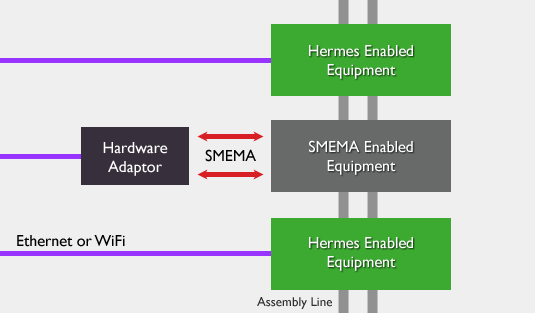
Creating a Scan Station using the SMEMA Hermes Adaptor
- Use this configuration for a situation where a PCB assembly line migrates into a IPC-HERMES-9852 compliant line, this maybe at the very start at the PCB loader or partway through. Also where a break in the compliance occurs and it has to be restored.
- Only the Downline SMEMA connector found on the equipment should be connected to the hardware adaptor. The Upline SMEMA connector found on the equipment should be connected to the Upline equipment, if any.
- By default the SMEMA ‘Machine Ready’ will be unset preventing any new PCBs from moving downline.
- Once the PCB ID has been scanned by serial barcode scanner, the PCB values are looked up using a third party data source and the normal Hermes handshake is made with the Downline equipment.
- Monitoring can be conducted by a web browser based user interface.
- Due to the nature of the web browser based user interface, it can be accessed from mobile devices that have access to the local network or using adjacent equipment that features a web browser.
Items required:
Hardware:
- SMEMA Hermes Adaptor
- USB-C Power Supply
- RJ12 to 14 way SMEMA connector (Male or Female) cable pair
Software:
- MultiPlug Edge Computing Platform - License Included
- MultiPlug.Ext.Hermes - Required for Hermes
- MultiPlug.Ext.Network.Sockets - Required for Sockets communication and third party data source lookup
- MultiPlug.Ext.Ports - Required for Serial Port Barcode Scanning
- MultiPlug.Ext.RasPi.GPIO - Required for the SMEMA I/O
SMT Line Sequence

Connection Diagram
